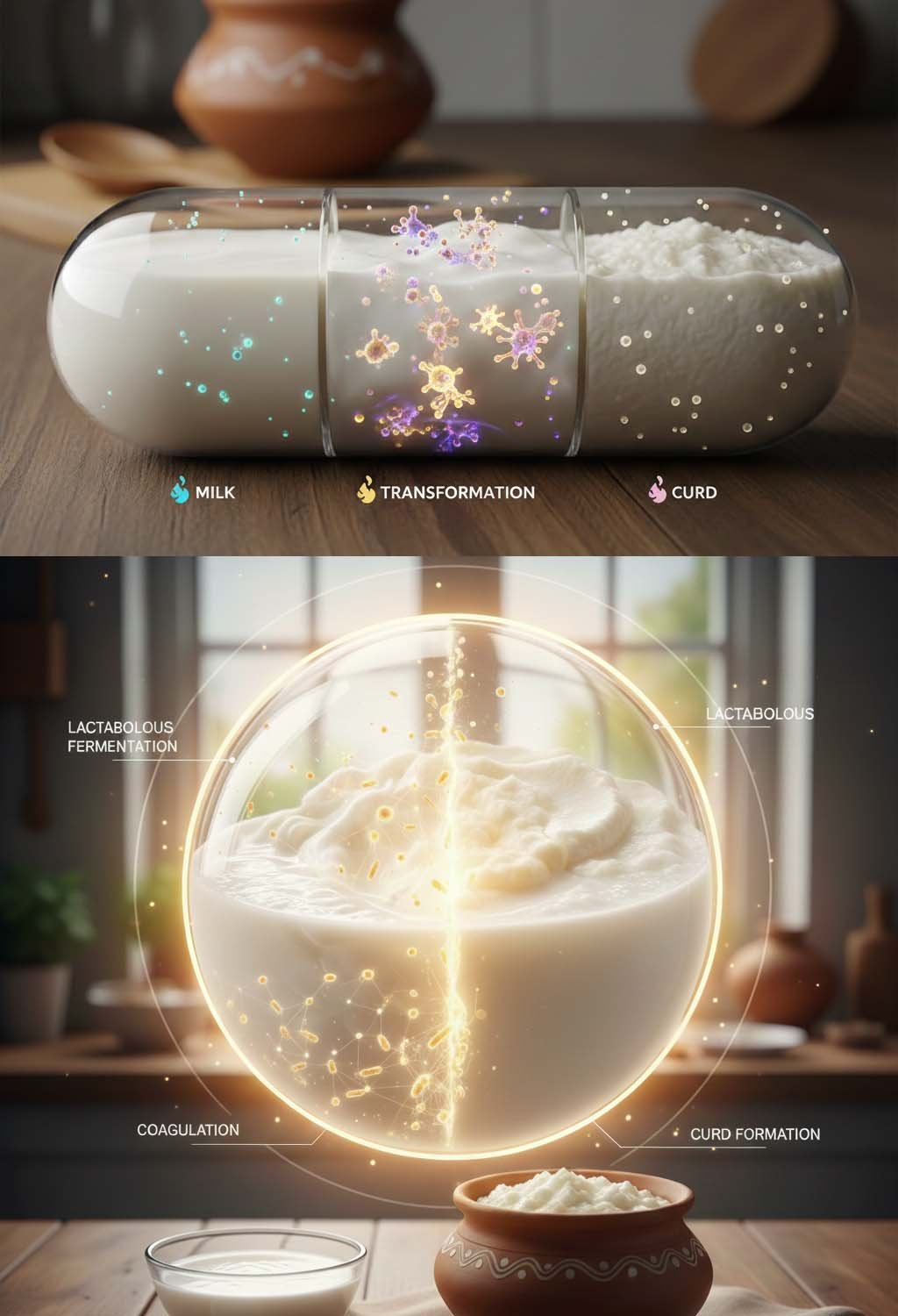Curd is prepared in a very good way in this season.
Optimal Temperature for Bacteria: The warmer temperatures of summer (typically 30∘C to 40∘C) are ideal for the growth and activity of the lactic acid bacteria (LAB) responsible for curdling milk.
Faster Lactic Acid Production: These bacteria thrive in the heat, rapidly converting lactose in the milk into lactic acid, which causes the milk proteins to coagulate and form the thick, set curd.
Accelerated Fermentation: The increased bacterial activity at higher temperatures leads to a much faster fermentation process compared to cooler seasons, resulting in perfectly set curd in less time.
Due to humidity and moisture, curd may become very thin.
The rainy season’s high humidity and often cooler temperatures can negatively impact curd consistency. The increased moisture in the air slows down the evaporation of water from the milk, preventing the curd from setting firmly. Additionally, slightly lower ambient temperatures can reduce the optimal activity of the lactic acid bacteria, leading to a weaker and thinner curd formation.
Curd may not be prepared in cold weather, but the temperature of the environment is normal. So, you can prepare curd in this season too.
Bacterial Activity Needs Warmth: While winter air is cooler, the crucial factor for curd setting is maintaining an optimal temperature (around 30∘C to 40∘C) for the lactic acid bacteria to convert lactose into lactic acid.
Creating a Warm Microclimate: Even if the room temperature is lower, you can create this necessary warmth by using insulation methods like wrapping the pot in a warm cloth, placing it in a warm spot (like near a gas stove after cooking, or inside a switched-off microwave), or using a warm water bath.
Extended Fermentation Time: The bacteria will still work in slightly cooler / normal temperatures, just at a slower rate. So, while it might take 8-12 hours or even longer to set in winter compared to 4-6 hours in summer, the curd will eventually form if given enough time and a consistent (even if lower) warm environment.

How to Make Traditional & Probiotic Curd at Home with CUHO Curd Making Capsules: The Scientific Process
Making delicious and healthy curd at home using CUHO Curd Making Capsules is a fascinating process rooted in microbiology. Whether you’re aiming for traditional dahi or a probiotic-rich variety, the underlying scientific principles are similar, guided by the activity of beneficial bacteria.
The journey begins with milk. For best results, use fresh, good-quality milk, whether it’s full-fat, low-fat, or even plant-based milk. The milk is first heated to a specific temperature, typically around 85∘C to 90∘C (185∘F to 195∘F), or brought to a rolling boil. This crucial step, known as pasteurization (or near-pasteurization in home settings), serves two primary purposes. Firstly, it eliminates any undesirable bacteria naturally present in the milk that could compete with or spoil the curd-making process. Secondly, heating helps to denature the whey proteins in the milk. This denaturation is vital because it improves the milk’s ability to form a firm, consistent curd structure later on, preventing a watery final product.
Once the milk has been heated, it must be cooled down to an optimal incubation temperature. This temperature is critical for the CUHO Curd Making Capsules to work effectively. The ideal range is usually between 35∘C to 45∘C (95∘F to 113∘F). If the milk is too hot, it will kill the beneficial bacteria in the capsule; if it’s too cold, the bacteria will become dormant and fail to multiply efficiently, resulting in a thin or unset curd. A good way to check is to insert a clean finger; it should feel comfortably warm, not hot.
Now comes the role of the CUHO Curd Making Capsule. Each capsule contains carefully selected strains of lactic acid bacteria (LAB). For traditional curd, these typically include Lactobacillus bulgaricus and Streptococcus thermophilus. If it’s a “probiotic” capsule, it will also contain specific probiotic strains like Lactobacillus acidophilus, Bifidobacterium lactis, or others, known for their gut health benefits. These bacteria are the “starter culture” for your curd. The contents of the capsule are then mixed thoroughly into the cooled milk. It’s important to ensure even distribution so that the bacteria have access to the entire volume of milk.
After mixing, the milk mixture is incubated. This involves placing the mixture in a warm, undisturbed environment for several hours. During this incubation period, the magic happens. The lactic acid bacteria in the CUHO capsule begin to ferment the lactose (milk sugar) present in the milk. As they consume lactose, they produce lactic acid. This lactic acid is the key player in curd formation. The increasing acidity of the milk causes the casein proteins (the primary proteins in milk) to coagulate and clump together. This coagulation process is what transforms the liquid milk into the semi-solid, gel-like consistency of curd. The more lactic acid produced, the firmer the curd becomes, up to a certain point. The probiotic strains, if present, also multiply during this fermentation, contributing their beneficial properties to the final product.
The time required for curd setting varies depending on the ambient temperature and the milk’s initial temperature. In warmer climates (like Nashik summers), it might set in 4-6 hours, while in cooler winters, it could take 8-12 hours or even longer. Once the curd has set to your desired consistency (usually evident when it doesn’t spill if tilted), it’s important to refrigerate it. Cooling the curd slows down the bacterial activity, preventing it from becoming too sour. Refrigeration also helps to further firm up the curd and extends its shelf life.
In essence, CUHO Curd Making Capsules provide a precise and reliable source of the right bacterial cultures, ensuring a consistent and healthy homemade curd every time. It’s a simple yet scientifically elegant way to enjoy fresh, probiotic-rich dahi right from your kitchen!



